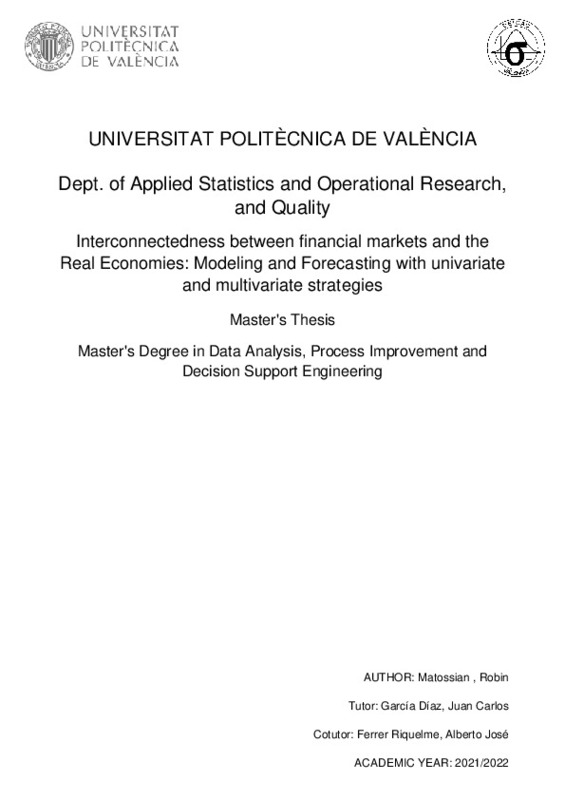JavaScript is disabled for your browser. Some features of this site may not work without it.
Buscar en RiuNet
Listar
Mi cuenta
Estadísticas
Ayuda RiuNet
Admin. UPV
Interconnectedness between financial markets and the Real Economies: Modeling and Forecasting with univariate and multivariate strategies
Mostrar el registro sencillo del ítem
Ficheros en el ítem
| dc.contributor.advisor | García Díaz, Juan Carlos
|
es_ES |
| dc.contributor.advisor | Ferrer Riquelme, Alberto José
|
es_ES |
| dc.contributor.author | Matossian, Robin
|
es_ES |
| dc.date.accessioned | 2022-10-20T11:54:45Z | |
| dc.date.available | 2022-10-20T11:54:45Z | |
| dc.date.created | 2022-09-26 | |
| dc.date.issued | 2022-10-20 | es_ES |
| dc.identifier.uri | http://hdl.handle.net/10251/188413 | |
| dc.description.abstract | [ES] Las economías de hoy forman un núcleo complejo de relaciones económicas y sociales. Por lo tanto, la aplicación de las Políticas Fiscal y Monetaria implica incertidumbre debido a la naturaleza dinámica de las economías actuales. En este contexto de incertidumbre, el objetivo será mejorar tanto la información como la toma de decisiones a la hora de aplicar las políticas gubernamentales. Reducir el riesgo subyacente en la toma de decisiones en entornos dinámicos. Este documento se centrará en los mercados financieros como fuente alternativa de datos. Gracias al hecho de que la mayoría de las economías avanzadas tienen mercados financieros bien establecidos. La información recopilada está avalada por entidades de interés público. Además, el marco regulatorio es particularmente robusto en los mercados financieros, lo que permite asegurar la viabilidad de los datos proporcionados por las bolsas de valores. En primer lugar, la realización de un análisis exploratorio determinará las estructuras de correlación entre los diferentes mercados y entre las variables macroeconómicas a predecir. Para describir de manera exhaustiva las relaciones de cada espacio, se realizarán Análisis Parciales de Mínimos Cuadrados y Análisis de Componentes Principales. Además, la programación de modelos de pronóstico univariados y multivariados permitirá predecir las principales variables macroeconómicas. El objetivo principal será comprender las relaciones subyacentes entre los mercados y la macroeconomía y pronosticar variables macroeconómicas como el PIB, la tasa de inflación y la tasa de desempleo. aumentando así la cantidad de información disponible en el proceso de toma de decisiones de Política Fiscal y Monetaria. | es_ES |
| dc.description.abstract | [EN] Today's economies form a complex nucleus of both economic and social relationships. Thus, applying Fiscal and Monetary Policies, involve uncertainty due to the dynamic nature of current economies. In this context of uncertainty, the objective will be to improve both information and decision-making when applying government policies. To reduce underlying risk in making decisions in dynamic environments. This paper will focus on the financial markets as an alternative source of data. Thanks to the fact that most advanced economies have well-established financial markets. The information gathered is guaranteed by public interest entities. In addition, the regulatory framework is particularly robust in financial markets, allowing to ensure the viability of the data provided by the stock markets. In the first place, performing an exploratory analysis will determine the correlation structures between the different markets and between the macroeconomic variables to be predicted. To exhaustively describe the relationships of each space, Partial Least Square Analysis and Principal Component Analysis will be performed. Furthermore, programming univariate and multivariate forecasting models will permit to predict main macroeconomic variables. The main objective will be to understand the underlying relations between markets and macroeconomics and to forecast macroeconomic variable as the GDP, the inflation rate and the unemployment rate. increasing this way the quantity of information available in the decision-making process of Fiscal and Monetary Policies. | es_ES |
| dc.format.extent | 70 | es_ES |
| dc.language | Inglés | es_ES |
| dc.publisher | Universitat Politècnica de València | es_ES |
| dc.rights | Reserva de todos los derechos | es_ES |
| dc.subject | Financial markets | es_ES |
| dc.subject | Economía real | es_ES |
| dc.subject | Mercados financieros | es_ES |
| dc.subject | Predicción | es_ES |
| dc.subject | Análisis de series temporales | es_ES |
| dc.subject | Forecasting | es_ES |
| dc.subject | Real economy | es_ES |
| dc.subject | Time series analysis | es_ES |
| dc.subject.classification | ESTADISTICA E INVESTIGACION OPERATIVA | es_ES |
| dc.subject.other | Máster Universitario en Ingeniería de Análisis de Datos, Mejora de Procesos y Toma de Decisiones-Màster Universitari en Enginyeria D'Anàlisi de Dades, Millora de Processos i Presa de Decisions | es_ES |
| dc.title | Interconnectedness between financial markets and the Real Economies: Modeling and Forecasting with univariate and multivariate strategies | es_ES |
| dc.title.alternative | Interconexión entre los mercados financieros y la economía real: Modelización y previsión con estrategias univariantes y multivariantes | es_ES |
| dc.title.alternative | Interconnexió entre els mercats financers i les economies reals: modelatge i pronòstic amb estratègies univariadas i multivariades | es_ES |
| dc.type | Tesis de máster | es_ES |
| dc.rights.accessRights | Abierto | es_ES |
| dc.contributor.affiliation | Universitat Politècnica de València. Departamento de Estadística e Investigación Operativa Aplicadas y Calidad - Departament d'Estadística i Investigació Operativa Aplicades i Qualitat | es_ES |
| dc.description.bibliographicCitation | Matossian, R. (2022). Interconnectedness between financial markets and the Real Economies: Modeling and Forecasting with univariate and multivariate strategies. Universitat Politècnica de València. http://hdl.handle.net/10251/188413 | es_ES |
| dc.description.accrualMethod | TFGM | es_ES |
| dc.relation.pasarela | TFGM\145162 | es_ES |






